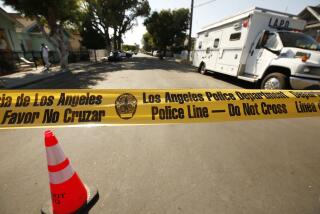Op-Ed: The package bombs are heinous and terrifying but not yet terrorism
- Share via
Every heinous act that causes terror is not necessarily terrorism. The pioneers of what we know today as terrorism sought to use violence not just to create carnage, but for the fear, death and destruction they could cause to deliver a political message. Johann Most, a 19th century German American anarchist, coined the phrase “propaganda of the deed” to describe terrorism.
The 10 package bombs mailed or delivered this week have succeeded in causing terror, but we shouldn’t call them terrorism, at least not yet.
The pipe bombs have created panic, dominated the news cycle and sent a message of generalized danger. If they also are meant to send a political message, it is so far unfocused beyond the fact that the targets were primarily Democrats, perceived to be rivals or perhaps enemies of President Trump. Remember, however, that letters containing a crude version of the poison ricin, sent to the president and senior Department of Defense officials earlier this month, were apparently motivated by a personal grievance; they were terrifying in their way, but not “terrorism.”
Sending people even ineffective bombs meets the definition of heinous, but we must wait for facts and evidence to determine whether this was indeed terrorism.
How we categorize the bombs will depend on facts and evidence we don’t have yet. We need to understand the motive and intent of the bomb maker or makers to make a determination. But facts and evidence already in hand can work to diminish the terror of the incidents, rendering them much less effective at shocking and frightening us.
Sending bombs to well known politicians, a movie star and a media company is a sure-fire way to get attention and disseminate fear. But of what exactly? Based on photographs and reporting, the bombs that have been intercepted since Monday appear to have all the components required to be viable. They will be considered “destructive devices” — the legal term for a bomb — when their author or authors is discovered and charged, but I am skeptical that they would have actually functioned.
The devices are typical pipe bombs, but very small ones. They were constructed using 6 inch lengths of 1 inch PVC pipe filled with low explosive powder; at least one reportedly contained glass shrapnel. The battery looks to be too small, and the gauge and length of the wire too large for the device to have exploded. Had one of these devices detonated, it could have caused injury, but it is very unlikely it would have caused death.
The bombs arrived in padded manila envelopes with very little effort to disguise their contents. Unlike most traditional letter or package bombs, they weren’t designed to detonate when the packages were opened. Instead, they were attached to a small digital clock that was presumably intended to function as a timer to detonate them at a particular time and date. We don’t know if it was indeed set, or even properly wired to complete the electrical circuit when the alarm was activated.
The envelope sent to CNN, which caused the company to evacuate Time Warner Center in Manhattan, contained a pipe bomb and a small envelope of as yet unidentified white powder, something often used in hoax letters intended to cause disruption in the years since a 2001 anthrax attack that killed five people. There was also a faux jihadist flag sticker affixed to the outside of the PVC pipe, of a design that is popular among some on the far right. To my eye, these pipe bombs are props intended to provoke panic rather than weapons.
Enter the Fray: First takes on the news of the minute from L.A. Times Opinion »
Of course, this is just one hypothesis out of several possible scenarios. It is also possible that the perpetrator is simply an amateur and that the bomb design flaws are a result of his (the bomb maker is probably male — most letter bombers are) inexperience at making explosive devices. He may have intended to kill those whose names were on the packages. We won’t know for certain until he is caught and investigated. (Capture is almost certain, given the amount of forensic evidence that will be recovered from these intact devices.)
Sending people even ineffective bombs meets the definition of heinous, but we must wait for facts and evidence to conclusively determine whether this was indeed terrorism or just an event that caused terror. In the meantime, by recognizing the limited threat these devices posed, the public can begin to defeat both terror and terrorism, and decrease the appeal for other attention-seeking individuals to copy this tactic.
Scott Stewart was the lead State Department investigator assigned to the 1993 World Trade Center bombing. He oversees terrorism analysis for Stratfor, a global intelligence firm based in Texas.
Follow the Opinion section on Twitter @latimesopinion and Facebook
More to Read
A cure for the common opinion
Get thought-provoking perspectives with our weekly newsletter.
You may occasionally receive promotional content from the Los Angeles Times.









